Email : [email protected]
Quick Contact: +91-9829821765
Direct Front Office: +91-9001319092
For Direct Booking: Quick Pay
Quick Contact: +91-9829821765
Direct Front Office: +91-9001319092
For Direct Booking: Quick Pay
About Udaipur
About Udaipur
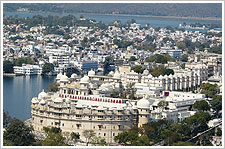 Udaipur was founded in 1559 by Maharana Udai Singh II as the final capital of the erstwhile Mewar kingdom, located to the southwest of Nagda, on the Banas River, the first capital of the Mewar kingdom. Legend has it that Maharana Udai Singh II came upon a hermit while hunting in the foothills of the Aravalli Range. The hermit blessed the king and asked him to build a palace on the spot, assuring him it would be well protected. Udai Singh II consequently established a residence on the site. In 1568 the Mughal emperor Akbar captured the fort of Chittor, and Udai Singh moved the capital to the site of his residence, which became the city of Udaipur.
Udaipur was founded in 1559 by Maharana Udai Singh II as the final capital of the erstwhile Mewar kingdom, located to the southwest of Nagda, on the Banas River, the first capital of the Mewar kingdom. Legend has it that Maharana Udai Singh II came upon a hermit while hunting in the foothills of the Aravalli Range. The hermit blessed the king and asked him to build a palace on the spot, assuring him it would be well protected. Udai Singh II consequently established a residence on the site. In 1568 the Mughal emperor Akbar captured the fort of Chittor, and Udai Singh moved the capital to the site of his residence, which became the city of Udaipur.
Lake Palace
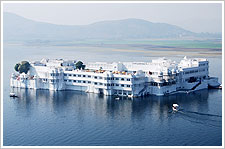 The Lake Palace was built in 1743-1746. It is made of marble and is situated on Jag Niwas island in Lake Pichola. It was originally built as a royal summer palace, but is now a luxury 5 Star hotel, operating under the "Taj Hotels Resorts and Palaces" banner.
The Lake Palace was built in 1743-1746. It is made of marble and is situated on Jag Niwas island in Lake Pichola. It was originally built as a royal summer palace, but is now a luxury 5 Star hotel, operating under the "Taj Hotels Resorts and Palaces" banner.
City Palace
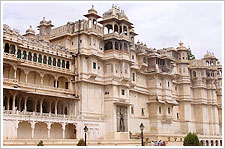 Standing on the east bank of Lake Pichola is a massive series of palaces built at different times from 1559. The balconies of the palace provide panoramic views of the "Jag Niwas.They also have views of Jag Mandir on one side and the city of Udaipur on the other. Its main entrance is through the triple-arched gate - the Tripolia, built in 1725. The way now leads to a series of courtyards, overlapping parations, terraces, corridors and gardens. There is a Suraj Gokhda, where the maharanas of Mewar presented themselves in the times of trouble to the people to restore confidence. The Mor-chowk (Peacock courtyard), gets its name from the mosaics in glass decorating its walls. The chini chitrashala is noteworthy while a series of wall paintings of Krishna are on display in Bhim Vilas. There are numerous other palaces such as Dilkhush mahal, Sheesh mahal, Moti mahal and Krishna vilas - in memory of a princess of striking beauty who poisoned herself to avert a bloody battle for her hand by rival princes. Now the palace contains many antique articles, paintings, decorative furniture and utensils and attracts thousands of visitors every day.
Standing on the east bank of Lake Pichola is a massive series of palaces built at different times from 1559. The balconies of the palace provide panoramic views of the "Jag Niwas.They also have views of Jag Mandir on one side and the city of Udaipur on the other. Its main entrance is through the triple-arched gate - the Tripolia, built in 1725. The way now leads to a series of courtyards, overlapping parations, terraces, corridors and gardens. There is a Suraj Gokhda, where the maharanas of Mewar presented themselves in the times of trouble to the people to restore confidence. The Mor-chowk (Peacock courtyard), gets its name from the mosaics in glass decorating its walls. The chini chitrashala is noteworthy while a series of wall paintings of Krishna are on display in Bhim Vilas. There are numerous other palaces such as Dilkhush mahal, Sheesh mahal, Moti mahal and Krishna vilas - in memory of a princess of striking beauty who poisoned herself to avert a bloody battle for her hand by rival princes. Now the palace contains many antique articles, paintings, decorative furniture and utensils and attracts thousands of visitors every day.
Fateh Sagar Lake
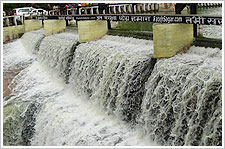 Fateh Sagar Lake is situated in the north of Lake Picholas. It was originally built by Maharana Jai Singh in the year 1678 AD, but later on reconstructed and extended by Maharana Fateh Singh after much destruction was caused by heavy rains. In 1993-1994, the water vanished from the lake, but in 2005-2006, the lake regained its water.
Fateh Sagar Lake is situated in the north of Lake Picholas. It was originally built by Maharana Jai Singh in the year 1678 AD, but later on reconstructed and extended by Maharana Fateh Singh after much destruction was caused by heavy rains. In 1993-1994, the water vanished from the lake, but in 2005-2006, the lake regained its water.
Lake Pichola
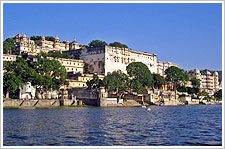 Lake Pichola has two islands, Jag Niwas and the Jag Mandir. This lake is 4 km long and 3 km wide, originally built by Maharana Udai Singh II. There are many ghats, like the bathing and washing ghats, which can be approached through boats from the City Palace of Udaipur (Bansi Ghat). In the heart of the lake the Lake Palace stands, which is now converted into a heritage palace hotel. The lake remains fairly shallow even during heavy rains, and gets dry easily in times of severe drought.
Lake Pichola has two islands, Jag Niwas and the Jag Mandir. This lake is 4 km long and 3 km wide, originally built by Maharana Udai Singh II. There are many ghats, like the bathing and washing ghats, which can be approached through boats from the City Palace of Udaipur (Bansi Ghat). In the heart of the lake the Lake Palace stands, which is now converted into a heritage palace hotel. The lake remains fairly shallow even during heavy rains, and gets dry easily in times of severe drought.
Gulab Bagh and Zoo
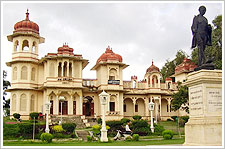 A rose garden laid out by Maharaja Sajjan Singh is situated near the palace on the east side of Lake Pichhola. A library in the garden has a collection of ancient handwritten manuscripts and books. Some of the part of the Satyarth Prakash have been written in this library. Styarth Prakash stup is situated in Gulab Bagh. Within the garden, there is a zoo with tigers, leopards, Chinkara gazelle, birds, and many wild animals. Children can enjoy mini train, track ofNehru Garden on an island in Fatah Sagar Lake which covers the main part of the garden and the zoo.
A rose garden laid out by Maharaja Sajjan Singh is situated near the palace on the east side of Lake Pichhola. A library in the garden has a collection of ancient handwritten manuscripts and books. Some of the part of the Satyarth Prakash have been written in this library. Styarth Prakash stup is situated in Gulab Bagh. Within the garden, there is a zoo with tigers, leopards, Chinkara gazelle, birds, and many wild animals. Children can enjoy mini train, track ofNehru Garden on an island in Fatah Sagar Lake which covers the main part of the garden and the zoo.
Doodh Talai
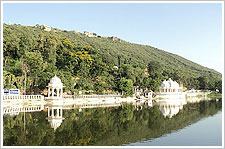 A rock and fountain garden and the sunset point from which one can enjoy the sunset view in Lake Pichhola and a panoramic view of the old city. Also one can enjoy the Aerial tramway (rope way) which connects one of the dudh talai gardens to Karni Mata temple.
A rock and fountain garden and the sunset point from which one can enjoy the sunset view in Lake Pichhola and a panoramic view of the old city. Also one can enjoy the Aerial tramway (rope way) which connects one of the dudh talai gardens to Karni Mata temple.
Ropeway in About Udaipur
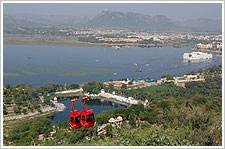 The ropeway to Karnimata temple was constructed to enable a large number of devotees who visit Karnimata Temple and other historic sites at Machhala Hill. The foot pathway, normally used by people, provides access to the top through a steep gradient. The Ropeway system has made it possible for all to visit the historical sites. Ropeway in Udaipur is newly introduced and is most important tourist attraction. It is installed between two mountains right on the bank of Lake Pichola. The view from the Gondolas is breath taking and if you have passion for photography you must not miss this. It is from here that you can click best view of Udaipur including Lake Pichola, Lake Fateh Sagar, magnificent City Palace complex, Sajjangarh Fort and above all artistic landscaped Aravali mountains on the other side of the lake. Do not miss the sun setting across lush green Aravali Hills across Lake Pichola. It takes no time to visit ropeway being in the heart of the City. It is located in the main tourist area and can be best visited in the evenings followed by mouth water cuisines.
The ropeway to Karnimata temple was constructed to enable a large number of devotees who visit Karnimata Temple and other historic sites at Machhala Hill. The foot pathway, normally used by people, provides access to the top through a steep gradient. The Ropeway system has made it possible for all to visit the historical sites. Ropeway in Udaipur is newly introduced and is most important tourist attraction. It is installed between two mountains right on the bank of Lake Pichola. The view from the Gondolas is breath taking and if you have passion for photography you must not miss this. It is from here that you can click best view of Udaipur including Lake Pichola, Lake Fateh Sagar, magnificent City Palace complex, Sajjangarh Fort and above all artistic landscaped Aravali mountains on the other side of the lake. Do not miss the sun setting across lush green Aravali Hills across Lake Pichola. It takes no time to visit ropeway being in the heart of the City. It is located in the main tourist area and can be best visited in the evenings followed by mouth water cuisines.
Sahelion ki Bari
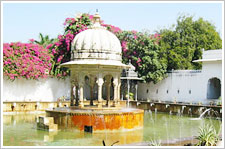 Saheliyon ki Bari or the "Garden of the maids of honour", brings to the fore the unique life-style of the royal ladies who once strolled in this gardens. This spectacular garden has four pools and five fountains, each one with a different look, embelished with delicately chiselled kiosks and elephants in marble. It also has a Science Laboratory with different types of reptiles, frogs and specimens for the visitors.
Saheliyon ki Bari or the "Garden of the maids of honour", brings to the fore the unique life-style of the royal ladies who once strolled in this gardens. This spectacular garden has four pools and five fountains, each one with a different look, embelished with delicately chiselled kiosks and elephants in marble. It also has a Science Laboratory with different types of reptiles, frogs and specimens for the visitors.
Sajjan Garh
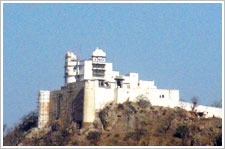 Sajjangarh Wildlife Sanctuary is situated 5kms in the West of tourist city Udaipur, which surrounds the Sajjangarh Palace overlooking Udaipur City. From the palace, one can have a magnificent view of lakes of Udaipur and Aravalli hill ranges. The view of Sunrise and Sunset attracts every visitor atop of Bansdara hill. Safari Park was created and wild animals like Chital, Sambar, Wild Boar, and Blue Bull were reintroduced. Animals like Panther, Hyena, Hare and Jackal has reappeared apart from variety of reptiles and birds. The wall extended further and now the entire hillock has been fenced, improving the vegetal cover of the sanctuary area.
Sajjangarh Wildlife Sanctuary is situated 5kms in the West of tourist city Udaipur, which surrounds the Sajjangarh Palace overlooking Udaipur City. From the palace, one can have a magnificent view of lakes of Udaipur and Aravalli hill ranges. The view of Sunrise and Sunset attracts every visitor atop of Bansdara hill. Safari Park was created and wild animals like Chital, Sambar, Wild Boar, and Blue Bull were reintroduced. Animals like Panther, Hyena, Hare and Jackal has reappeared apart from variety of reptiles and birds. The wall extended further and now the entire hillock has been fenced, improving the vegetal cover of the sanctuary area.
Chittorgarh Fort
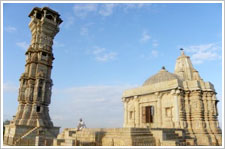 Rajputana is the most impressive aspect of the Indian history and Chittorgarh is a symbol of prestige, honour and elegance of Rajputana. I am sure that whenever a child starts reading history books in Indian schools or even think something about history, his first introduction begins with the heroism of Maharana Pratap, sacrifice of Panna Dhai, Love of Meera Bai,Bravery of Gora-Badal and Jauhar (Sacrifice in the Fire) of Queen Padmini. He/she must feel pride on these stories and interestingly, all these stories were born in the fort of Chittorgarh. This was the place where Meera Bai jovially took the sip from a cup of poison in the love of Lord Krishna, Panna Dhai sacrificed her son on the altar of her duty, Queen Padmini and many other ladies happily jumped in the Jauhar fire to protect their honour. Which one could be the more glorious chapter than this in the Indian History? If you wish to see and feel these stories, then you must visit Chittorgarh fort once in a lifetime.
Rajputana is the most impressive aspect of the Indian history and Chittorgarh is a symbol of prestige, honour and elegance of Rajputana. I am sure that whenever a child starts reading history books in Indian schools or even think something about history, his first introduction begins with the heroism of Maharana Pratap, sacrifice of Panna Dhai, Love of Meera Bai,Bravery of Gora-Badal and Jauhar (Sacrifice in the Fire) of Queen Padmini. He/she must feel pride on these stories and interestingly, all these stories were born in the fort of Chittorgarh. This was the place where Meera Bai jovially took the sip from a cup of poison in the love of Lord Krishna, Panna Dhai sacrificed her son on the altar of her duty, Queen Padmini and many other ladies happily jumped in the Jauhar fire to protect their honour. Which one could be the more glorious chapter than this in the Indian History? If you wish to see and feel these stories, then you must visit Chittorgarh fort once in a lifetime.
Eklingji Temple
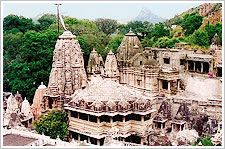 Rajputana Stories are not only about heroism and bravery. They also had a great faith in their family God or Goddess. Lord Shiva is the family god of Mewar Dynasty in the form of Eklingji. The kings of Mewar dynasty only ruled as a representative of Eklingji. This temple is 1300 years old and made of marbles. The Temple is very grand and magnificent in conception and perfect in execution. Hindu pilgrims come here from far places throughout the year to worship the Lord Eklingji. The descendant of Mewar Dynasty still come here on every Monday to offer their prayers to Lord Eklingji and to seek his blessings.
Rajputana Stories are not only about heroism and bravery. They also had a great faith in their family God or Goddess. Lord Shiva is the family god of Mewar Dynasty in the form of Eklingji. The kings of Mewar dynasty only ruled as a representative of Eklingji. This temple is 1300 years old and made of marbles. The Temple is very grand and magnificent in conception and perfect in execution. Hindu pilgrims come here from far places throughout the year to worship the Lord Eklingji. The descendant of Mewar Dynasty still come here on every Monday to offer their prayers to Lord Eklingji and to seek his blessings.
Nagda
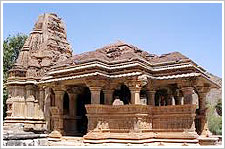 It is located 23 kms from Udaipur. The extension tour ex. Udaipur.. The first capital of Bappa Rawal, the ancient palace has a magnificent torana or arch which is ornately carved. The tenth century Sas Bahu temples dedicated to Sas ( mother in-law) and Bahu ( daughter in-law ) are rated among the best temples in India. There is a lake surrounded by temples. The jain temple is worth visiting.
It is located 23 kms from Udaipur. The extension tour ex. Udaipur.. The first capital of Bappa Rawal, the ancient palace has a magnificent torana or arch which is ornately carved. The tenth century Sas Bahu temples dedicated to Sas ( mother in-law) and Bahu ( daughter in-law ) are rated among the best temples in India. There is a lake surrounded by temples. The jain temple is worth visiting.
Nathdwara
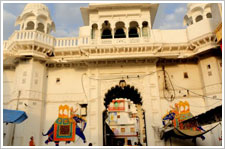 Nathdwara is 55 km from Udaipur. Devoted to Lord Krishna, Shrinathji Temple houses a black stone image of lord Krishna. Legend goes that that the statue was brought from Vrindavan in 1669 to protect it from Aurangazeb. The wheels of the cart carrying the statue were stuck in the deep mud while passing through Nathdwara, and consequently the Srinathji temple was built on the spot with the permission of the then Rana of Mewar at Nathdwara.
Nathdwara is 55 km from Udaipur. Devoted to Lord Krishna, Shrinathji Temple houses a black stone image of lord Krishna. Legend goes that that the statue was brought from Vrindavan in 1669 to protect it from Aurangazeb. The wheels of the cart carrying the statue were stuck in the deep mud while passing through Nathdwara, and consequently the Srinathji temple was built on the spot with the permission of the then Rana of Mewar at Nathdwara.
Haldighati
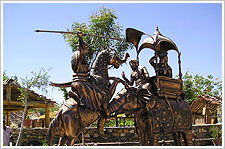 Battle of Haldighati is an important battle of Indian History, that wrote a new chapter in the history of Rajputana. Maharana Pratap never accepted subordination of the Mughal Emperor Akbar and fought bravely with Mughal army in the Battlefield of Haldighati. However, Mughal army outnumbered Rajput Army and seeing that the battle was lost, Pratap’s generals prevailed upon him to flee the field so as to be able to fight in the future. In the same battle of Haldighati, Mana Jhaala, a general of Maharana Pratap, wrote a new tale of loyalty. He donned Pratap’s armor and took his place in the battlefield to confuse the Mughal army and facilitated Pratap’s escape.In the process, he fought bravely and died in the battlefield. This battlefield also witnessed the indomitable valor of Chetak, loyal horse of Maharana Pratap. Despite the injuries, he took out Pratap safely from the battlefield and died thereafter. The memorial of Chetak is there in Haldighati and it is a true tribute to the heroism of that horse.There is also a museum at Haldighati, which has a great collection of the stories related to the battle of Haldighati in the form of sculptures as well as portraits. In addition to this, Haldighati area is also famous for the cultivation of Chaitri Roses ( a type of rose). These roses are used in the production of Rose water, Rose syrup and perfumes and these products are famous worldwide today.
Battle of Haldighati is an important battle of Indian History, that wrote a new chapter in the history of Rajputana. Maharana Pratap never accepted subordination of the Mughal Emperor Akbar and fought bravely with Mughal army in the Battlefield of Haldighati. However, Mughal army outnumbered Rajput Army and seeing that the battle was lost, Pratap’s generals prevailed upon him to flee the field so as to be able to fight in the future. In the same battle of Haldighati, Mana Jhaala, a general of Maharana Pratap, wrote a new tale of loyalty. He donned Pratap’s armor and took his place in the battlefield to confuse the Mughal army and facilitated Pratap’s escape.In the process, he fought bravely and died in the battlefield. This battlefield also witnessed the indomitable valor of Chetak, loyal horse of Maharana Pratap. Despite the injuries, he took out Pratap safely from the battlefield and died thereafter. The memorial of Chetak is there in Haldighati and it is a true tribute to the heroism of that horse.There is also a museum at Haldighati, which has a great collection of the stories related to the battle of Haldighati in the form of sculptures as well as portraits. In addition to this, Haldighati area is also famous for the cultivation of Chaitri Roses ( a type of rose). These roses are used in the production of Rose water, Rose syrup and perfumes and these products are famous worldwide today.
Kumbhalgarh Fort
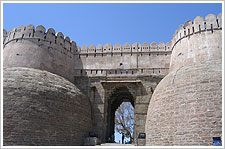 Kumbhalgarh..This name itself carries some weight. It is the second most important fort in the history of Rajputana, after Chittorgarh Fort. After the sacrifice of Panna Dhai at Chittor, Kunwar Udai Singh was brought here secretly, so that he could be safe here from Banwari. Maharna Pratap was also born in the same fort. The outer walls of this fort are 15 feet thick and spread over the perimeter of 36 kms. These walls are believed to be the second longest continuous walls, after the Great Wall of China. The location of this fort in the middle of hills and dense forests made it inaccessible from invaders.Situated at the height of 1100 meters, this fort’s defenders could easily tracked any enemy movement from miles away. Perhaps that’s why this fort could not be conquered ever. Only once in the history, the combined armies of Akbar, Maan Singh, Udai Singh of Marwar and Sultanate of Gujarat were able to breach the security of this fort for a short period, that too because of the shortage of water supply in the fort. There are many Hindu and Jain temples inside the fort. A grand light show is held every day in the evening and it is an amazing experience to see this fort in those colorful artificial lights.
Kumbhalgarh..This name itself carries some weight. It is the second most important fort in the history of Rajputana, after Chittorgarh Fort. After the sacrifice of Panna Dhai at Chittor, Kunwar Udai Singh was brought here secretly, so that he could be safe here from Banwari. Maharna Pratap was also born in the same fort. The outer walls of this fort are 15 feet thick and spread over the perimeter of 36 kms. These walls are believed to be the second longest continuous walls, after the Great Wall of China. The location of this fort in the middle of hills and dense forests made it inaccessible from invaders.Situated at the height of 1100 meters, this fort’s defenders could easily tracked any enemy movement from miles away. Perhaps that’s why this fort could not be conquered ever. Only once in the history, the combined armies of Akbar, Maan Singh, Udai Singh of Marwar and Sultanate of Gujarat were able to breach the security of this fort for a short period, that too because of the shortage of water supply in the fort. There are many Hindu and Jain temples inside the fort. A grand light show is held every day in the evening and it is an amazing experience to see this fort in those colorful artificial lights.
Ranakpur Jain Temple
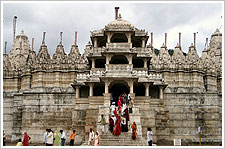 Between the splendid palaces and formidable forts of Rajasthan, the Jain Temple at Ranakpur still attracts people’s attention with full splendor. Built in the 15th century, this temple is situated at a place that seems neither like a town nor like a village and surrounded by the Aravali Hills and dense forests. About 1000 carved pillars of this temple are beautiful pieces of craft skills on the white marble stones. Some even say that it is impossible to count all the pillars. Interestingly, no two pillars are having same carvings. Here, a union of sun rays with white marble stones happens in such a manner that at every hour for some period the color of these white stones looks like blue pale. Description of the beauty of Ranakpur’s Temple is beyond the words.This temple is a blissful combination of architecture, sculpture and crafts.
Between the splendid palaces and formidable forts of Rajasthan, the Jain Temple at Ranakpur still attracts people’s attention with full splendor. Built in the 15th century, this temple is situated at a place that seems neither like a town nor like a village and surrounded by the Aravali Hills and dense forests. About 1000 carved pillars of this temple are beautiful pieces of craft skills on the white marble stones. Some even say that it is impossible to count all the pillars. Interestingly, no two pillars are having same carvings. Here, a union of sun rays with white marble stones happens in such a manner that at every hour for some period the color of these white stones looks like blue pale. Description of the beauty of Ranakpur’s Temple is beyond the words.This temple is a blissful combination of architecture, sculpture and crafts.




